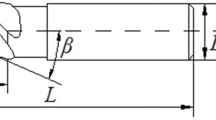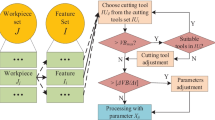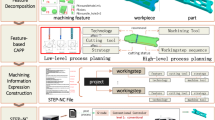Abstract
There is a variety of schemes when a part with multiple features is processed in CNC machines, and hence, different feature sequencing and cutting parameter selections affect not only productivity but also energy consumption. This paper concentrates on the energy-saving strategy by optimizing the feature processing sequence and machining parameters in the part processing stage through reducing the energy consumption of the non-cutting and cutting process respectively. Firstly, the energy consumption of the cutting of parts is established using unit volume cutting energy (SEC) on cutting volume, while the normal feed and the rapid feed are established in different moving axes, respectively. Meanwhile, the detailed energy model is established considering rapid feed and general feed path in the X, Y, Z + , Z − directions for analyzing the impact of feature sorting on reducing the energy consumption of non-cutting. The non-cutting energy consumption model is established involving automatic tool change, ordinary feed, and fast feed factors. Based on the developed model, the multi-objective optimization of cutting energy consumption, machining quality, and machining time is carried out by NSGA-II algorithm, and the path optimization of empty cutting energy consumption is carried out by genetic algorithm. Finally, a cutting orthogonal experiment is executed to collect energy consumption data, analyze the data, and fit the data to establish a specific energy consumption model for each processing stage. A case study of a part with eight features is used to optimize sequencing and parameters, which shows the effectiveness and validity of the proposed method.










Similar content being viewed by others
Availability of data and material
All the data have been presented in the manuscript.
References
Gutowski TG, Allwood JM, Herrmann C, Sahni S (2013) A global assessment of manufacturing: economic development, energy use, carbon emissions, and the potential for energy efficiency and materials recycling. Annu Rev Environ Resour 38:81–106
Zhou L, Li J, Li F, Meng Q, Li J, Xu X (2016) Energy consumption model and energy efficiency of machine tools: a comprehensive literature review. J Clean Prod 112:3721–3734
Gutowski TG, Branham MS, Dahmus JB, Jones AJ, Thiriez A, Sekulic DP (2009) Thermodynamic analysis of resources used in manufacturing processes. Environ Sci Technol 43(5):1584–1590
Duflou JR, Sutherland JW, Domfeld D, Herrmann C, Jeswiet J, Kara S, Hauschild M, Kellens K (2012) Towards energy and resource efficient manufacturing: a processes and systems approach. CIRP Ann Manuf Technol 61(2):587–609
Chen X, Li C, Tang Y, Li L, Li H (2021) Energy efficient cutting parameter optimization. Front Mech Eng 16(2):221–248
Hu L, Liu Y, Peng C, Tang W, Tang R, Tiwari A (2018) Minimising the energy consumption of tool change and tool path of machining by sequencing the features. Energy 147:390–402
He Y, Li Y, Wu T, Sutherland JW (2015) An energy-responsive optimization method for machine tool selection and operation sequence in flexible machining job shops. J Clean Prod 87:245–254
Sheng P, Srinivasan M, Kobayashi S (1995) Multi-objective process planning in environmentally conscious manufacturing: a feature-based approach. CIRP Ann Manuf Technol 44(1):433–437
Newman ST, Nassehi A, Imani-Asrai R, Dhokia V (2012) Energy efficient process planning for CNC machining. CIRP J Manuf Sci Technol 5(2):127–136
Srinivasan M, Sheng P (1999) Feature based process planning in environmentally conscious machining—part2: macroplanning. Robot Comput Integr Manuf 15(3):271–281
Lv J, Tang R, Jia S, Liu Y (2016) Experimental study on energy consumption of computer numerical control machine tools. J Clean Prod 112:3864–3874
Lv J, Tang R, Jia S (2014) Therblig-based energy supply modeling of computer numerical control machine tools. J Clean Prod 65:168–177
Li Y, He Y, Wang Y, Wang Y, Yan P, Lin S (2015) A modeling method for hybrid energy behaviors in flexible machining systems. Energy 86:164–174
Balogun VA, Mativenga PT (2013) Modelling of direct energy requirements in mechanical machining processes. J Clean Prod 41:179–186
Gara S, Bouzid W, Amar MB, Hbaieb M (2009) Cost and time calculation in rough NC turning. Int J Adv Manuf Technol 40(9):971–981
He Y, Tian X, Li Y, Wang S, Sutherland JW (2020) Modeling machining energy consumption including the effect of toolpath. Procedia CIRP 90:573–578
Deja M, Siemiatkowski MS (2013) Feature-based generation of machining process plans for optimised parts manufacture. J Intell Manuf 24(4):831–846
Wiener R (2003) Branch and bound implementations of the traveling salesperson problem - part 4: distributed processing solution using RMI. J Object Technol 2(2):65–86
Guo Y, Mileham A, Owen G, Maropoulos P (2006) Operation sequencing optimization using a particle swarm optimization approach. Proc Inst Mech Eng Part B J Eng Manuf 220(12):1945–1958
Gan PY, Lee KS, Zhang YF (2001) A branch and bound algorithm based process-planning system for plastic injection mould bases. Int J Adv Manuf Technol 18(9):624–632
Lee DH, Kiritsis D, Xirouchakis P (2001) Branch and fathoming algorithms for operation sequencing in process planning. Int J Prod Res 39(8):1649–1669
Lee DH, Kiritsis D, Xirouchakis P (2001) Search heuristics for operation sequencing in process planning. Int J Prod Res 39(16):3771–3788
Hu L, Tang R, He K, Jia S (2015) Estimating machining-related energy consumption of parts at the design phase based on feature technology. Int J Prod Res 53(23):7016–7033
Reddy SVB (1999) Operation sequencing in CAPP using genetic algorithms. Int J Prod Res 37(5):1063–1074
Gutowski TG, Dahmus J, Thiriez A (2006) Electrical energy requirements for manufacturing processes. 13th CIRP International Conference of Life Cycle Engineering, Lueven
Velchev S, Kolev I, Ivanov K, Gechevski S (2014) Empirical models for specific energy consumption and optimization of cutting parameters for minimizing energy during turning. J Clean Prod 80(1):139–149
Kara S, Li W (2011) Unit process energy consumption models for material removal processes. CIRP Ann Manuf Technol 60(1):37–40
Wong TN, Chan L, Lau H (2003) Machining process sequencing with fuzzy expert system and genetic algorithms. Eng Comput 19(2–3):191–202
Feng CH, Chen X, Zhang JY, Huang YG (2021) A generalized analysis of energy saving strategies through experiment for CNC milling machine tools. Int J Adv Manuf Technol 1–13
Funding
This research is funded by the National Natural Science Foundation of China Grant No. 51605294. Shi Huang, Guozhen Bai, Xiang Chen and Haohao Guo are thanked for providing technical support during the experiments.
Author information
Authors and Affiliations
Contributions
Chunhua Feng: conceptualization, methodology, software, validation, writing-original draft, funding acquisition. Yugui Huang: investigation, data curation, software. Yilong Wu: investigation, data curation, resources. Jingyang Zhang: investigation, data curation, resources.
Corresponding author
Ethics declarations
Ethics approval
Not applicable.
Consent to participate
The authors declare that they all consent to participate this research.
Consent for publication
The authors declare that they all consent to publish the manuscript.
Competing interests
The authors declare no competing interests.
Additional information
Publisher's note
Springer Nature remains neutral with regard to jurisdictional claims in published maps and institutional affiliations.
Rights and permissions
About this article
Cite this article
Feng, C., Huang, Y., Wu, Y. et al. Feature-based optimization method integrating sequencing and cutting parameters for minimizing energy consumption of CNC machine tools. Int J Adv Manuf Technol 121, 503–515 (2022). https://doi.org/10.1007/s00170-022-09340-8
Received:
Accepted:
Published:
Issue Date:
DOI: https://doi.org/10.1007/s00170-022-09340-8




